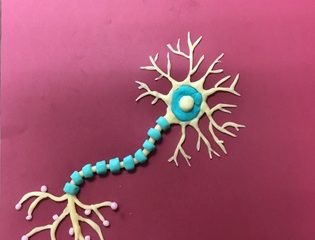The latest recommendation from a student looks at differences between males and females with anorexia. Not only are eating disorders much more frequent in females than males, but males seem to recover more readily than females.

Spain recently banned the use of ultra-skinny models for fashion runway shows, hoping that young women would be less inclined to copy this image.
In order to participate, models should have a BMI of 18.5, which is considered the lower limit of healthy weight. Cathy Gould, of the Elite Model Agency in New York, responded by asking, “what about discrimination against the model and what about the freedom of the designer?”
Michael Strober and his colleagues at UCLA looked at the progress of 99 patients with anorexia between the ages of 13 and 17 years, 14 of whom were males [1]. A year after treatment, none of the boys had relapsed, compared to over 8% of the girls. Further research will be necessary to determine the causes of the sex differences in prevalence and recovery.
1. Strober, M., Freeman, R., Lampert, C., Diamond, J., Teplinsky, C., & DeAntonio, M. (2006). Are there gender differences in core symptoms, temperament, and short-term prospective outcome in anorexia nervosa? Journal of Eating Disorders, 30, 570-575.



16 Comments
MollyMcLaughlin · November 6, 2006 at 3:40 pm
From my own personal experience, I find this data to be right-on. I have a male cousin who suffered from anorexia and after about 12 months of treatment and therapy, he seems to be doing really well. On the other hand, I have four female friends who have suffered from this as well. Three of the four have had major relapses (more than once) and have been in and out of treatment over the past six years. Are the causes of anorexia similar for both sexes?
LeaRoltsch · November 7, 2006 at 3:02 am
This is a very sad and touchy topic, but I don’t believe that it is wrong for anorexic models not to be allowed to work. Not only because they are not portraying a healthy image to young impressionable girls, but also because they themselves need help. I have an aunt who has had problems with anorexia, it is very hard on the individuals who have it and those they are close to. Anorexia is an ongoing battle for many.
nelsayed · November 7, 2006 at 12:54 pm
I was actually able to talk about this topic in abnormal psychology. We had a class discussion on the implications of this and whether or not its fair. I do agree that there are some women that have “gazelle like” figures, but the average female does not. For many women the fashion world represents an ideal women that they feel they need to look like to be beautiful. Many women also hold the misconception that this is what men also want them to look like. Many of the models themselves also recieve pressure from the fashion industry to lose weight. I think that Spain banning skinny models is a positive step towards fixing a major problem. I don’t think women should be made to feel that being that skinny is healthy and beautiful.
MunkeyChowFan · November 7, 2006 at 7:00 pm
While I may not have friends who suffer from anorexia, I do have an impressionable seventeen year-old sister. The claim that preventing anorexic women from modeling is discrimination, is misguided. I’m fairly sure it’s out of concern for the welfare of the model, as well as the implicit message conveyed to women that being anorexic is acceptable and necessary to be considered beautiful. I wasn’t even aware that anorexia is an issue with some men.
emhughes · November 7, 2006 at 7:56 pm
I too have a close female friend who is diagnosed with Anorexia and has relapsed numerous times. I wonder if the difference in male and female recovery/relapse has anything to do with social expectations.
PinkShades05 · November 13, 2006 at 1:08 am
I took a trip with one of my female friends who is a model. She suffered from anorexia a few years ago, but she continued to have eating problems well after she recovered. It is devasting how all this pressure to look a certain can push girls into destroying their health. I do wonder how much of this pressure really comes from society. There must be something more to this than just wanting to be like all the other skinny models.
MollyMcLaughlin · November 13, 2006 at 1:28 pm
In response to your comment, PinkShades, I do agree that there must be something more than wanting to be like other skinny models. While I am sure some young women do suffer from anorexia because of society’s pressure to be thin, I’ve noticed in my friends that in their cases, it was a control issue. For one of my friends who was really a perfectionist/Type-A personality, food was the one thing in her life she felt complete dominance and control over. She would work countless hours on schoolwork, relationships, etc. but often the results were out of here control. So to her, food was this opportunity to gain control in her life. Has anyone else heard of such reasons?
triciagordon3213 · November 14, 2006 at 1:31 pm
I think it’s ridiculous that Cathy Gould from the Elite Modeling Agency thinks that anoerexic girls use skinny models as a scape goat for their weight problems. Models are protrayed as beautiful in our society and when young girls see these skinny models they want to be beautiful too. If aneorexic models are supposed to be beautiful then what’s to stop other young women from copying this trend in order to be beautiful? I think that these powerful modeling agencies should be setting an example for young people not helping worsen the problem.
AshleyGrinchis · November 27, 2006 at 7:11 pm
In response to other peoples comments, some girls become anoerexic because they are modeling and trying to keep up with the stereotype. One of my best friends in high school was pushed by her mother to become anoerexic because she was modeling and doing commercials. However, I do believe that the reaseon she was able to actually become anoerexic was because of her Type A perfectionistic personality. So it can defintely be a combination of both personality traits and the stereotype of what models should look like.
katiecrawford · December 2, 2006 at 6:31 pm
I could not agree more with Ashley when she says that anorexia is linked to Type A perfectionist personalities. I learned in abnormal psychology that eating disorders are found to be more prevalent on Cal Poly’s campus than others. One possible explanation for this finding is that Cal Poly tends to attract type A personalities. Overall Cal Poly is one of the top state colleges in California. Our “learn by doing” motto attracts a person who is organized, assumes the leader position and it highly achieving. Therefore it makes sense to link that those personality traits with someone who is Type A personality
kellyandreson · December 6, 2006 at 2:36 pm
As the body image and eating disorder coordinator for Cal Poly Women’s Programs my initial reaction was positive to the weight regulations for models in Spain. However, further thought leads me to feel that this is not fair. Some women are naturally thin and have a low BMI. It wouldn’t be fair to exclude these women. This is the equivalent of putting an OFFICIAL ban on women who weigh too much or have too high BMI (although our current standards do hold an unofficial ban on these particular women).
Milissa · December 6, 2006 at 4:51 pm
Regardless of gender, anorexia is a major problem. I feel that a lot of the problem does deal with the societal pressures to be thin. There are ultimately many things that can drive a person whether male or female to have eating disorders and whatever the case, the problem obviously needs to be addressed. On the topic of models, I have never found these anorexic models to be appealing. The fact that the clothes just hang off of them, they have no curves and their bones are petruding out of their skin is just unappealing. I am really surprised that the modeling industry has allowed it to get this bad. It seems that there is much more emphasis being placed on this problem and hopefully because society is becoming more aware of it, things will begin to change. These models need to take a look back in history and remember the fame from those such as Marilyn Monroe who is to this day still looked at as beautiful.
MICHELLEdoerner · December 7, 2006 at 3:34 pm
I think all eating disorders have to do with mental feedback. On many of the shows I watch on eating disorders, the people have such a distortion of their weight. I think eating disorders are tied into habit and positive reinforcement. I too, agree that Type A personality can be linked to eating disorders since these people tend to be orderly and high achieving. These people see results they like and will want to keep going. However, somewhere along the line, they lose sight of the negative consequences and do not see the real picture of what they look like. I do think there should be a line drawn as to how skinny a model can be, just as there are other limits in our society. Yet, I can see how limitation is a sensitive topic and would be hard to determine where the line should be drawn.
jejabe13 · December 8, 2006 at 12:04 am
Wow, this is such an interesting finding. I’m surprised by the data suggesting males with anorexia have a better recovery outlook than females. It seems like social support encouraging normative eating when trying to battle an eating disorder would be preventative in relapse. And it seems that men would be less likely to be open with such a disorder, therefore receiving less social support. I hope further studies will examine differences in the environmental factors between males and females to relapse and those who don’t. I also wonder if there is any similar research relating to those with other forms of eating disorders, such as bulimia.
Laura’s Psychology Blog » New Year’s Resolutions and Weight Loss…. · December 31, 2006 at 12:43 pm
[…] As an aside, one marvels at the contrasts we find in our culture between an epidemic of obesity on one hand, and anorexia nervosa on the other. […]
Laura’s Psychology Blog » When thin becomes too thin…. · February 6, 2007 at 2:39 pm
[…] The fashion industry, which of course forms the context for Prada, is beginning to assume some responsibility for eating disorders that might arise from the influence of ultra-thin models. As we mentioned in a previous post, Spain banned models with BMIs below 18 from their fashion shows. […]
Comments are closed.